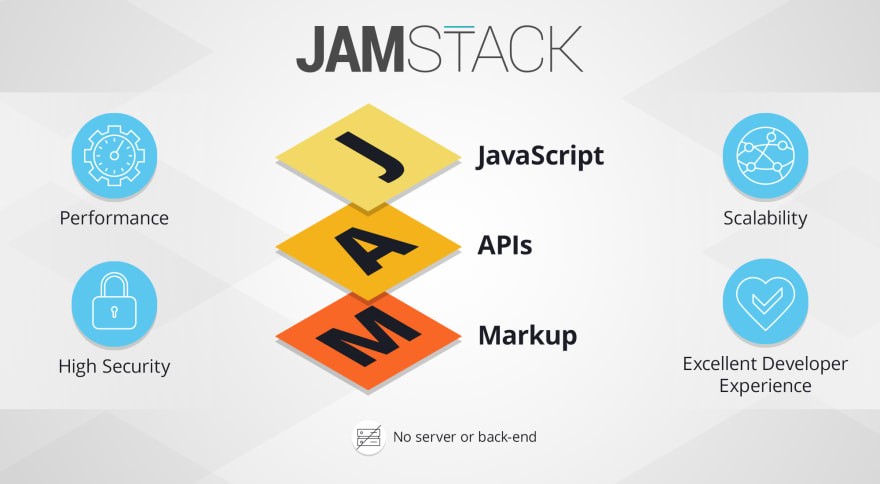How Jamstack and Static Site Generators Are Revolutionizing Web Development
 Abdullah Developer
Abdullah Developer
Have you ever wondered how modern websites achieve lightning-fast speeds and seamless performance? The secret often lies in an exciting new approach called Jamstack. If you’re curious about how static site generators revolutionize web development, you’re in the right place. In this blog post, we’ll explore what Jamstack is, why it’s gaining popularity, and how you can use it to build faster, more efficient websites.
What is Jamstack?
Jamstack isn’t a tool or framework; it’s a modern architecture for building websites and web applications. The name "Jamstack" comes from the core components:
JavaScript: Handles the dynamic functionalities.
APIs: Connect to services and data sources.
Markup: Static HTML files pre-built at deployment time.
In simpler terms, Jamstack focuses on decoupling the front end from the back end, using static files for the front end and APIs for server-side functionalities. This approach can significantly boost performance and flexibility.
Why Choose Jamstack?
Speed and Performance
Static sites are incredibly fast. Since the pages are pre-built and serve as static HTML files, they load quickly without waiting for server-side processing. This results in a smoother experience for users and can positively impact your site’s SEO.
Security
With Jamstack, your site is less vulnerable to security risks because there’s no need for a live server or database to manage. Static files are served directly from a CDN (Content Delivery Network), reducing potential attack vectors.
Scalability
Scaling with Jamstack is straightforward. Since static files can be easily distributed across multiple servers via a CDN, handling traffic spikes becomes much simpler. You don’t need to worry about scaling a server or managing infrastructure.
Developer Experience
Developers love Jamstack because it simplifies the development process. You can focus on building features with JavaScript and leverage APIs for complex functionalities. Static site generators streamline workflows, making maintaining and deploying websites easier.
Popular Static Site Generators
Let’s take a look at some popular static site generators that are driving the Jamstack movement:
Gatsby
Gatsby is a popular choice for building static websites and web applications. It uses React and GraphQL to create fast, modern sites. Gatsby’s rich ecosystem of plugins and themes makes it easy to add features and integrate with various services.
Next.js
Next.js is known for its flexibility. While it supports static site generation, it also offers server-side rendering for dynamic content. It’s built on React and provides a smooth development experience with built-in support for routing and API routes.
Hugo
Hugo is known for its speed and simplicity. It’s written in Go and is great for generating static sites quickly. Hugo’s straightforward setup and fast build times make it a solid choice for many developers.
Jekyll
Jekyll is one of the oldest static site generators and is widely used with GitHub Pages. It’s simple to use and integrates well with GitHub, making it a popular choice for personal blogs and project documentation.
Getting Started with Jamstack
If you’re ready to dive into Jamstack, here’s a step-by-step guide to get you started:
Choose a Static Site Generator
Pick a static site generator that suits your needs. Consider factors like the tech stack, ease of use, and community support.
Set Up Your Development Environment
Install the necessary tools and dependencies for your chosen static site generator. This usually involves setting up Node.js, npm, and the generator itself.
Create Your Project
Use the generator’s CLI (Command Line Interface) to create a new project. Follow the documentation to set up your project structure, add content, and configure settings.
Build and Deploy
Build your static site using the generator’s build command. Once built, deploy your site to a hosting provider. Many static site generators integrate with platforms like Netlify, Vercel, and GitHub Pages for easy deployment.
Add Functionality
Enhance your site by integrating APIs for dynamic content, forms, or authentication. You can use JavaScript libraries or frameworks to add interactive features.
Real-World Examples
Several well-known websites and applications use the Jamstack architecture:
Smashing Magazine: A popular design and web development magazine that leverages Gatsby for fast and responsive content delivery.
TinaCMS: An open-source CMS built with React and Gatsby, showcasing how Jamstack can be used to create modern content management systems.
Conclusion:
Jamstack is a modern architecture for building lightning-fast, secure, and scalable websites by decoupling the front end from the back end. Utilizing static site generators like Gatsby, Next.js, Hugo, and Jekyll, Jamstack simplifies development, enhances performance, and improves security. In this article, learn how Jamstack works, why it's gaining popularity, and how to get started with building efficient web applications using this innovative approach.
Subscribe to my newsletter
Read articles from Abdullah Developer directly inside your inbox. Subscribe to the newsletter, and don't miss out.
Written by
